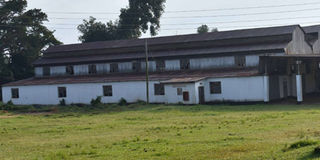Why Busoga farmers stopped growing cotton

Sacrificed. The former Kamuli Cotton Ginnery that has been turned into a teachers college. PHOTO/SAM CALEB OPIO.
What you need to know:
- According to Historian Thomas Taylor, cotton was not grown on plantations, but on individual holdings by peasants. But by 1918, Busoga had 101,000 acres of cotton under cultivation compared to 36,695 acres in Buganda.
During his secondary school days, former Lands minister Daudi Migereko says he had his own cotton garden.
“I was a cotton ginner in Bulumba for a couple of years and we had taken a decision to plant 500 acres supported by irrigation. We were also moving away from producing lint, only to yarn; but unfortunately, we were forced to get out of that business,” he says.
However, Mr Migereko, 64, says cotton growing areas of Bulamogi, Buyende, Bugiri, Busiki, Mayuge, Bugweri, Luuka and parts of Iganga eventually abandoned the trade and turned to other crops such as sugarcane and coffee with the perception that they fetch more money.
Busoga Sub-region and the cattle corridor areas of Namasagali-Mbulamuti, Balawoli-Kagumba and Nabwigulu were all cotton growing areas, the reason a railway line used to go through the area to collect and ferry the crop to industries.
Prince Emmanuel Babalanda, the deputy prime minister of Bugabula Chiefdom, on Monday said the cotton industry was “killed” by the privatisation policy when government started paying farmers through vouchers.
“Farmers lost interest as they were not getting the money when the privatisation policy came up with paying vouchers and chits,” Mr Babalanda pointed out
Lack of incentives
Mr James Mpaulo, the Kamuli District agriculture officer, said farmers abandoned cotton growing in the area due lack of incentives.
“Government put the last nail in its coffin when it adopted a single spine system, hence sidelining technical people in cotton development,” he said.
“Originally, farmers were getting free cotton seeds, field staff technical guidance and assured market; but now, they are buying seeds whose performance is poor and paying for the services,” Mr Mpaulo revealed.
He also pointed out that production has been affected by the explosive population growth, which has led to land fragmentation that does not favour cotton-growing.
“With land fatigue, it calls for use of fertilisers, yet the youth divert their production energies to boda boda business, while the elderly, who have the experience, don’t have the energy. So, the whole chain system from planting, harvesting to post-harvest handling is affected,” Mr Mpaulo explained.
Mr Jafari Isiko, the agricultural officer for Magada Sub-county in Namutumba District, said in the 1960s and 1980s when government was buying cotton and determining its prices, things used to be better.
He said when government stopped supporting farmers to grow cotton, private companies have taken over yet their terms are unfavourable.
“Agricultural officers and extension officers have been left out in the process of encouraging farmers to grow cotton,” he said, adding that cotton seeds are now being sold by private companies at higher prices yet accessing them is very difficult.
“Cotton price fluctuations have also discouraged farmers from growing cotton because prices rise during planting and fall during harvest,” he said.
Mr Moses Kintu Kulabako, a resident of Kagulu Village, Kagulu Sub-county in Buyende District, who grew cotton for 30 years, said he decided to change to rice farming, citing “unproductivity” of cotton growing.
Mr Augustine Ntalo, a resident of Waluwere Village, Ivukula Sub-county in Namutumba District, said he decided to grow groundnuts because of their ready market.



